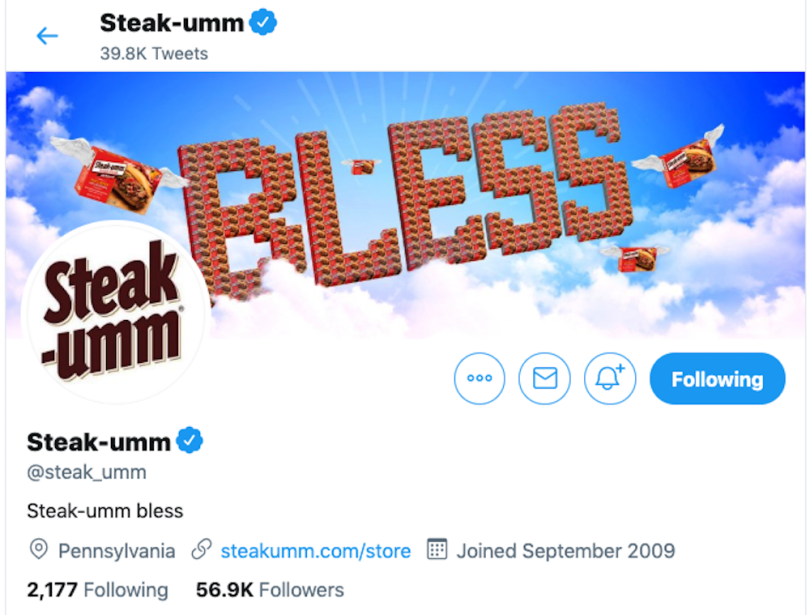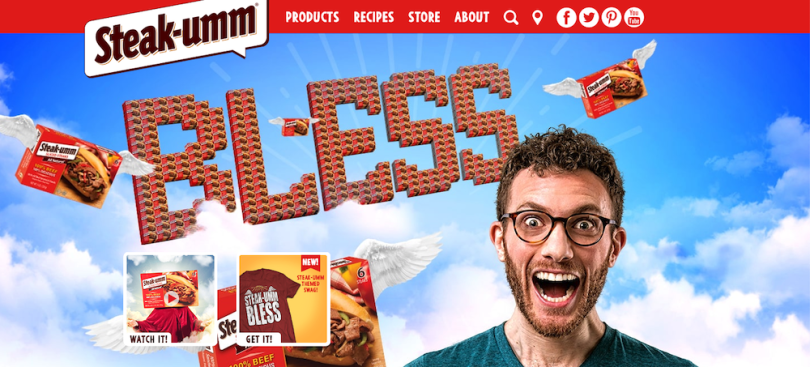
Nathan Allebach is a 28-year old with a podcast and a beard. On Twitter, he’s also a verified frozen beef brand.
“It is just kind of me,” he said of Steak-umm’s Twitter account, @Steak_umm.
Allebach is a social media manager at Allebach Communications, and one of the many people who work in content marketing. Interestingly, he eschews marketing strategy altogether and instead shares “off the cuff” thoughts on a brand account. (Certain topics are off-limits on the Steak-umm account, though — like, for instance, Jesus.)
And it’s working. @Steak_umm has amassed more than 55,000 followers. In Allebach’s first year and change running the account, sales rose by about 15 percent, and they continue to climb. The account has also garnered extensive mainstream media coverage, including a mention in the New York Times alongside fellow humanoid brand accounts Netflix and Vita Coco.
Some find the Steak-umm account’s hybrid brand-human persona uncanny; others find it delightful. It’s certainly specific. In Steak-umm tweets, Allebach refers to the company’s signature boxed sandwich steak as “frozen beef sheets” (“it’s accurate,” he said) and calls Steak-umm followers “beeflings.” He signs off particularly philosophical tweets with “Steak-umm bless,” a catchphrase that’s also the account’s bio as well as a sweatshirt slogan.
Allebach described the overall aesthetic as goofy, philosophical, blunt and “self-aware.”
In one of Allebach’s most popular tweetstorms, for example, he/Steak-umm wrote: “[W]hy are so many young people flocking to brands on social media for love, guidance, and attention? I'll tell you why. they're isolated from real communities, working service jobs they hate while barely making ends meat [sic]… they grew up through the dawn of internet culture and have had mass advertising drilled into their media consumption… being behind a screen 24/7 has made them numb to everything… there's so much to process and very few trusted, accessible outlets to process it all through. so they go to memes. they go to obscure or absurdist humor. they go to frozen meat companies on twitter. end rant”.
The thread spawned multiple thinkpieces. Vox opined that Steak-umm was “trying to prove its chill authenticity.” The AV Club wrote that “while this would be a pretty good rumination on online life from, say, a friend... there’s something deeply unsettling about it coming from the mouthpiece of a corporate brand.”
Allebach, for his part, articulated the appeal this way: “It admits… we’re a brand. We're participating in this broader model of consumerism and advertising that we can't really escape. And while we're here, we'll make criticism and commentary, and we'll kind of make fun of ourselves.”
The thread was so self-deprecating, some thought the Steak-umm account had been hacked. Others surely thought their social media manager had lost the plot. Really, though, it was a major professional success for Allebach, getting nearly 12,000 retweets. Excelling at content marketing and critiquing it; speaking as a guy and speaking as a brand — in this industry, it all blurs together.

What is content marketing, anyway?
Content marketing is distinct from what people typically think of as marketing: glossy magazine ads, TV commercials or a shouty car salesman on the radio. That’s all what the marketing industry terms “push marketing,” which interrupts popular media to “push” an unwanted promotional message on consumers. When advertisers pay to place those types of messages, they’re paying to address an audience that someone else cultivated.
Content marketing, on the other hand, attempts to cultivate its own audience — much the way traditional media does — and operates on a pull model. For that approach to work, experts in the field often caution, companies can’t just release bland streams of random content. Their content has to be “valuable, relevant and consistent.” In other words, it has to serve consumer needs — for entertainment, information or advice — and reach them when they need it, over and over.
What is Content Marketing?
It’s a marketing tack that dates back to at least 1895, when agricultural manufacturer John Deere launched a print magazine, The Furrow, that continues to publish. It wasn’t until more than a century later, however that content marketing really took off in response to the rise of internet adblocking technology.
People have always been able to ignore ads. But with ad-blocking, ads weren’t even guaranteed background-chatter status — they were entirely avoidable. Growing out of the TV sphere, where VCRs and then DVRs let people record shows and fast forward through commercials, ad-blockers emerged as browser extensions and mobile apps.
By 2008, marketing guru Seth Godin announced, “[C]ontent marketing is the only marketing left.” At the time, he meant it was the only kind of marketing that could build long-term, mutually beneficial relationships between brands and consumers — the only kind of marketing consumers would willingly permit into their lives.
As people migrated from desktop computers to mobile devices, though, and ad blockers proliferated, Godin’s proclamation became more literally true. Androids have always supported ad blockers; in 2015, the iPhone operating system began supporting them, too. By 2016, almost one fifth of Americans used adblocking apps.
“It’s... a sign that consumers are tuning out,” said Stephanie Stahl, General Manager at the Content Marketing Institute.
They were at least tuning out traditional push marketing. Content marketing, on the other hand, was exploding. In 2016, it was an almost $200 billion global industry, forecasted to more than double by 2021.

Yes, content marketing has a fandom
Rarely does anyone drop the phrase, “I love content marketing!” into casual conversation. Explore the industry, though, and you’ll find that some of it is quite popular. People follow branded social media accounts and listen to branded podcasts of their own volition.
Steak-umm’s Twitter, for one, achieved a surprising groundswell of popular support in 2017.
The account wasn’t always popular. Allebach and the rest of the team at his dad’s company, Allebach Communications, took charge of Steak-umm’s account in August of 2017. At that point, Steak-umm had about 1,000 followers but wasn’t very active on the platform. The brand had essentially been driven off Twitter.
“They couldn't promote anything without it getting completely ratioed” by snark from Weird Twitter, a loose group of surrealist comedians, Allebach told Built In. (A tweet gets “ratioed” when it gets many more negative replies than retweets or favorites.)
In response, Allebach changed Steak-umm’s Twitter persona so it felt less like the clueless corporate entities that get roasted on the Fellow Kids subreddit. And it worked. The Twitter trend shifted from razzing Steak-umm to semi-ironically campaigning for the account to be verified. Allebach sometimes gets credit for engineering that campaign, but in reality he joined it. It was, he said, “grassroots” and a “gag.”
The hashtag #VerifySteakUmm remains a repository of semi-ironic enthusiasm. Some supportive tweets are from fellow food brands; others involve fan art that replaces Simba with a box of Steak-umm in a scene from the Lion King. According to Twitter’s help page, though, the blue verified check mark “lets people know that an account of public interest is authentic.” Did Steak-umm meet that qualification?
Short answer: Yes. After coverage of the campaign from outlets like the Huffington Post, Twitter “bent the knee” and verified the account in January of 2018. Public opinion was on Steak-umm’s side.
Other brands have charmed the nation with content, too. Grocery chain Trader Joe’s had a landslide success — one that perhaps even eclipses Steak-umm’s — when it released a podcast called Inside Trader Joe’s in 2018. The first five-episode season was a bona fide hit, reaching number three on the iTunes podcast charts and even edging out comedian and martial arts commentator Joe Rogan’s consistently top-rated show, The Joe Rogan Experience.
“There is nothing [in the branded audio space] as successful as… Trader Joe's,” said Steven Goldstein, CEO of branded audio studio Amplifi.
Like Steak-umm’s tweets, the Trader Joe’s podcast has an air of frankness about it. There are fewer “beeflings,” sure, but it’s not pure pep either. After all, it dedicates a segment to unpopular products Trader Joe’s has had to phase out. Like cream of venison soup from Lapland. (Despite being poetically hawked as “cuisine from the land of the midnight sun,” it was not a hit.)

Content and cash
By traditional media standards, the Trader Joe’s podcast was a home run. By marketing standards, though, its success was less clear. The marketing industry often focuses less on popularity than conversion rates — the number of sales prompted by a given marketing strategy.
The journey from promotion to a sale, however, is a long one — one that marketers often represent as a funnel. Its top layer is typically awareness of a brand; in the middle, there’s active engagement with the brand’s sales apparatus, and at the tapered bottom is the actual purchase. (The funnel tapers as the layers’ demographics shrink; more people know about a brand than buy from it.)
Content marketing, by most estimations, operates at the top of the funnel, raising awareness but rarely triggering a straightforward sale. Which is to say, it’s very unlikely that someone who has never shopped at Trader Joe’s would listen to the chain’s podcast and then sprint to the nearest location for bananas.
Instead, content marketing kicks off a long process. The best way to see how it drives conventional conversions is by using a multi-touch attribution system, which tracks every interaction a brand has with a customer prior to purchase. (The first interaction might be a Facebook ad; the second a branded podcast; the third a promotional email.) These sophisticated systems also weigh the separate interactions, or “touches,” according to a customizable model, giving them each a certain percentage of credit for the sale.
But because multi-touch attribution remains imperfect, struggling to capture phenomena like word of mouth, Stahl recommends judging content marketing by a broader definition of conversion. In that framework, content succeeds whenever it moves a consumer measurably towards “profitable action.” That could mean it prompts podcast subscriptions, social media follows or email newsletter signups. Ideally, Stahl said, content gets consumers to join an audience that a brand can manage independently — for example, an email list — as opposed to a platform-dependent audience that’s cultivated on Twitter or Facebook.
“We [marketers] all want a known audience that we manage, that we have [unmediated] access to,” she said. “You want to have an audience that you can call your own.”
In both traditional media and content marketing, an audience’s value is also determined by engagement metrics. That includes time spent on a web page, actively engaging with what's there. As departing Deadspin editor Megan Greenwell wrote in a blog post, digital media increasingly considers time spent reading their sites as a more valuable metric than, say, overall pageview counts. In other words, an audience that demonstrates interest has more value than an audience that could have accidentally clicked through to a branded blog post.
That’s not specific to written content, though — the best audiences engage actively with content no matter the format. They listen to podcasts and watch videos from beginning to end. They don’t just follow Steak-umm’s Twitter account — they read the posts and retweet them.
Audience demographics matter, too. Someone who’ll never need your product or service is less valuable than someone who might need it, who is in turn less valuable than someone actively seeking it. For niche brands, especially, it makes more sense to judge content by the number and caliber of sales leads it generates than by the size of its audience.
Take the podcast HVAC School. Hosted by Bryan Orr, who also owns an HVAC contracting business (Kalos Inc.), it functions as content marketing by raising the profile of his business as it delves into HVAC-specific questions such as, “Is testing capacitors under load better?”
“That’s a niche play,” said Goldstein admiringly.
Orr agreed that his podcast was niche — it has an audience of about 100,000 per episode, which “compared to the Marc Marons of the world is nothing.” Compared to zero, though, it’s a lot, in part because it covers an “established industry that’s underserved” by traditional media.
What’s more, the audience consists of HVAC professionals, which means the podcast’s potential to drive profitable action is huge. In addition to helping Orr recruit employees and attract referrals from industry compatriots, the pod has attracted major sponsors like Carrier and generates about $120,000 a year in ad revenue.
Like Goldstein and Orr, Stahl enthused about niche content marketing. At its best, she said, content marketing has a “clearly defined target audience… it's just not effective to try to be all things to all people.”

What does tech have to do with content?
In a way, the tech industry created content marketing. Not only did it pioneer ad blockers, it produced the digital platforms where brands can share messages without media licenses. On TV and radio, information can be distributed only through licensed channels. On Facebook TV and podcasting apps, though, there’s no such oversight.
Today, “there's no reason anybody can't be a media company,” said Steve Pratt, vice president at branded audio studio Pacific Content. The barrier to entry has fallen.
Content marketers use technology every day, too. Marketing software is a multi-billion dollar industry, and content marketers rely on software to manage their workflows, optimize their content’s search-engine placement, and gauge the size and engagement levels of audiences. Some software helps with content creation, suggesting topics and SEO-friendly phrasings in real time. Another nascent trend is automation, which refers mainly to automated content distribution and curation as opposed to creation.
The best content marketing software often rolls a variety of these functions into one cohesive whole. Content marketing platforms from HubSpot, Marketo and NewsCred are especially popular, according to a Technavio report.
“The number of technologies available to make it easier for marketers to create, distribute and measure their content marketing efforts is impressive,” Stahl said.
Not that every content marketer needs every technology.
“I think there's the same issue with technology in every industry, right? Sometimes you buy the tech before you know what the problem you really need to fix is,” Stahl added. “We, of course, always recommend a careful look at planning and strategy and process before applying an actual technology to it.”
The one tried-and-true marketing method tech hasn’t yet bested: old-fashioned buzz.
“The number one way that people discover content, even with all the sophisticated tools we have today, is friends and friend circles,” said Goldstein. “That's as low-tech as you can get.”

The future of content
The content marketing sector is forecasted to grow, but no one knows what that growth will look like. Stahl, for her part, hopes it becomes more strategic and quality-focused.
“We are constantly trying to push the idea that you don't necessarily have to create a ton of content, but you have to create some great content or amazing content,” she said. “Put the focus on the quality... it's better to just have a smaller amount of really great content than it is a whole bunch of mediocre content.”
Goldstein has a similar view of audio content marketing. It’s a crowded market; by his estimate, there are 740,000 podcasts, most of which don’t make it past their eighth episode. Human attention is a limited resource, and there just isn’t enough of it to go around.
“People are going to become more discerning in what they choose to listen to,” Goldstein predicted. That means succeeding in content marketing will become “number one [an] awareness issue: how do I know that you're doing it? Two, why should I listen? [And] three, how do I listen? ... That's the magic trio.”
Allebach said he foresees “a period of ultimate chaos” on the social media side of content marketing. Writing for New York, he observed that the tone of Brand Twitter fundamentally changes every year or so. This year, for instance, is the year of branded sadness; 2014 was the year of attempts at coolness, featuring “bae” and “on fleek” tweets. The change, he suspects, will only speed up. The days of marketers focusing on “consistent messaging” and long-term brand infrastructure have passed.
“We're seeing the kind of breakdown of the traditional institutions” — not just in marketing, but in all kinds of communication, Allebach noted. Brands, he thinks, will start acting more like pundits, seeking attention “even if it’s literally for… a few hours.”
“It's going to be a lot more bizarre, absurd, ironic, outrageous, ridiculous stuff that's brands are doing,” he said. “And not all of it's going to be bad.”
Take Steak-umm’s decision to become, at least on Twitter, Nathan Allebach. It doesn’t appeal to everyone, but nothing does — and it entrances some people so completely that they Google the Steak-umm account, find Allebach’s name and get in touch. Through the brand account, Allebach has made “dozens” of real-life friends.
So yes, people may discover content marketing primarily through analog conversations with friends — but these days, people also find friends through absurdist content marketing.





